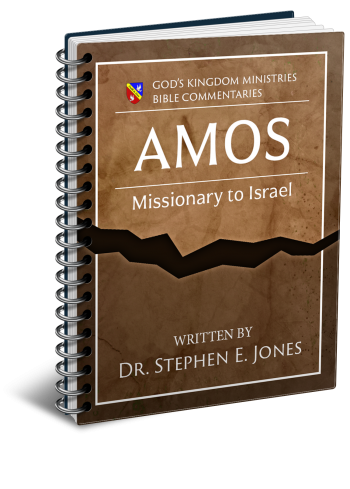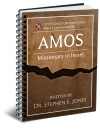Latest Posts
View the latest posts in an easy-to-read list format, with filtering options.

Amos was a missionary from Judah to Israel, giving them a final warning to repent before divine judgment was to destroy the nation. They refused, and two years later the nation was struck by a massive earthquake that destroyed their defenses and allowed the Assyrians to conquer them easily.
Category - Bible Commentaries

Amos 9:1 says,
1 I saw the Lord [eth Yahweh] standing beside the altar, and He said, “Smite the capitals so that the thresholds will shake and break them on the heads of them all! Then I will slay the rest of them with the sword. They will not have a fugitive who will flee, or a refugee who will escape.”
This is the final vision in the series that began in chapter 7 and continued into chapter 8. This time, however, instead of seeing symbols such as locusts, fire, plumb line, and a basket of figs, Amos sees the Lord Himself.
This is one of the 134 places where the rabbinical commentators (the Sopherim) changed Yahweh to Adonai in the Hebrew text. Dr. Bullinger points out that the text actually reads eth Yahweh, which he renders as “Yahweh Himself.” He says that the appearance of Yahweh in person differs from the symbols in the previous visions.
The Hebrew word eth is actually two letters: aleph and tav, the first and last letters of the Hebrew alphabet. It has far greater significance than just pointing to Yahweh Himself. It also identifies Yahweh as the same God seen in Rev. 22:13, written in Greek, where Jesus tells John,
13 I am the Alpha and the Omega, the first and the last, the beginning and the end.
Writing in Greek, John uses the first and last letter of the Greek alphabet, but this is but a Greek translation of the aleph-tav. Here Jesus identifies Himself as “the first and the last.” Another way of putting it is that He is “the Author and Finisher of our faith” (Heb. 12:2, KJV).
In Gen.1:1 the Creator is called Elohim eth (aleph-tav). In that case the eth is untranslatable. It is instead a way of identifying the Creator as the aleph and the tav, or (in Greek) the alpha and omega. John 1:1 tells us that “in the beginning was the Word” (Logos), and the apostle points out that Jesus Christ is that Logos. John 1:3 continues,
3 All things came into being by Him, and apart from Him nothing came into being that has come into being.
The term, “in the beginning,” is encompassed in the aleph, while the completion of creation and the restoration of all things is the tav. Not all Christians understand either aleph or tav, but only those who understand universal reconciliation can begin to comprehend the tav.
The tav was originally written as a cross or X. When Judah was taken to Babylon for their 70-year captivity, they adopted the Aramaic letters of Babylon which are used today. But originally, it was written as a cross, the “mark” of God in Ezekiel 9:4, God’s signature.
The cross, then, was what made “the end” (tav) possible, for Jesus said in John 12:32, 33,
32 “And I, if I be lifted up from the earth, will draw all men to Myself.” 33 But He was saying this to indicate the kind of death by which He was to die.
In other words, if Jesus were to die on the cross, being lifted up between heaven and earth, He would “draw all men” to Himself. In essence, this defines the meaning of the tav, “the end,” or what His death would accomplish. And, of course, He did die on the cross.
John shows us that Jesus Christ was the Creator in the beginning (aleph) as well as the successful result or end (tav) of history. Moses referred to Christ as Elohim eth, the God whose creative power made a beginning of all things. Amos referred to Him as eth Yahweh, the God of the Covenant, whose promise to draw all men to Himself and to restore all things will be fulfilled by the end of time.
Today, we know Him by the name revealed in the New Testament. In English it is Jesus, in Greek it is Iesous, in Hebrew it is Yeshua. But in His pre-incarnate state, He was YHWH, spelled in various ways by different translators. The Old Testament Scriptures prophesy of Him whenever it speaks of “salvation” (Heb., Yeshua or yasha). So Moses writes in Exodus 15:2 (literally),
2 Yahweh is my strength and song, and He has become my Yeshua; this is my God [Elohim], and I will praise Him; my father’s God, and I will extol Him.
Isaiah 12:2, 3 quotes Moses, telling us,
2 Behold, Elohim [God] is my Yeshua, I will trust and not be afraid, for the Yah Yahweh is my strength and song, and He has become my Yeshua. 3 Therefore you will joyously draw water from the springs [or wells] of Yeshua.
Jesus understood that this prophesied of Himself when He quoted Isaiah in John 7:37, 38,
37 … “If any man is thirsty, let him come to Me and drink. 38 He who believes in Me, as the Scripture said, “From his innermost being shall flow rivers of living water.”
In other words, Isaiah’s prophecy was to be fulfilled in Yeshua Himself, because “Yahweh has become my Yeshua.”
Amos sees the Aleph-Tav Yahweh “standing beside the altar.” What altar? Some say that he saw Yahweh standing by the altar in the temple in Jerusalem. The Geneva Bible, for instance, first translated in 1560 and revised in 1599 (a few years before the KJV), writes in its notes on this verse:
9:1 Which was at Jerusalem; for he appeared not in the idolatrous places of Israel.
The Geneva Bible was the first to be translated by a committee, rather than a single translator. It also contained notes and explanations, which often opposed the notion of “the divine right of kings.” This infuriated King James in England, causing him to produce a second translation without the notes that monarchs found offensive. We know it as the 1611 King James Bible.
It was the belief at the time that God would not go near an idolatrous altar. Hence, the translators concluded that Amos saw God standing beside the altar in Jerusalem.
Yet we know that God sent a prophet to prophesy judgment at the altar in Bethel (1 Kings 13:1, 2). Would God send a prophet to a place where He Himself would not go?
Certainly, God would not send anyone to a pagan altar for the purpose of worshiping there. Yet idolatrous places needed to hear the warning of impending judgment. The most natural reading of Amos 9:1 was that the Lord Himself showed up at the altar in Bethel to render His verdict against the golden calf, the altar, and the shrine as a whole. It does not seem likely that God issued His verdict from Jerusalem.
The divine verdict was to destroy the temple or shrine at Bethel. “Smite the capitals” (kaphtor, “capitals of a pillar”). Hence, the structure had pillars holding up a heavy roof. It was a large building.
The foundations too were to be shaken, “and break them on the heads of them all.” A capital is like a head on a pillar, so it is likely that Amos was comparing those capitals to the heads of the priests being judged at Bethel.
The worshipers themselves were also to be judged, for the Lord says, “Then I will slay the rest of them with the sword.” No one will escape. There will be no fugitives or refugees to escape the disaster. Since many Israelites were actually taken into captivity to Assyria, it is clear that not all of the Israelites were killed, but even those captives ultimately died in the land of their captivity.
Hence, the prophecy in Amos 9:1 focused upon the priests ministering at the shine of the golden calf, along with the most faithful of those idolaters.
Amos 9:2 continues,
2 Though they dig into Sheol, from there shall My hand take them; and though they ascend to heaven, from there will I bring them down.
They cannot escape divine judgment by going underground (“into Sheol”), nor can they escape by ascending to heaven.
Neither can they hide somewhere on the surface of the earth or the bottom of the sea. Amos 9:3 says,
3 And though they hide on a summit of Carmel, I will search them out and take them from there; and though they conceal themselves from My sight on the floor of the sea, from there I will command the serpent and it will bite them.
God (through Amos) paints the word picture of sinners attempting unsuccessfully to avoid the judgment of God. Amos 9:4 puts the final stroke of the brush to this painting:
4 And though they go into captivity before their enemies, from there I will command the sword that it slay them, and I will set My eyes against them for evil and not for good.
No doubt these captives died in Assyria. However, sending Israel into captivity in Assyria was not the end of the matter. In fact, it was only the start of judgment, during which time, God stated, “I will set My eyes against them for evil and not for good.”
The scope of these words should not be understood as a final condition but as the beginning of a time of “evil” that would endure until the end of Israel’s “seven times” of judgment. All such judgment has an end, but this particular judgment was to be the longest that the nation had ever experienced.
Amos 9:5, 6 says,
5 And the Lord God [Adonai Yahweh] of hosts, the One who touches the land so that it melts, and all who dwell in it mourn, and all of it rises up like the Nile of Egypt; 6 the One who builds His upper chambers in the heavens, and has founded His vaulted dome over the earth, He who calls for the waters of the sea and pours them out on the face of the earth, The Lord [Yahweh] is His name.
First, we should recognize that the common use of the term, “The Lord,” is not a name but a title denoting ownership. The Jews did not want to speak His name for fear of taking His name in vain, and so they read Adonai, “Lord,” in its place. There is nothing inherently wrong with this practice, especially since the prophets themselves often used the term in reference to Yahweh.
Amos 9:5 (above) uses the term Adonai Yahweh, which could be translated as Lord Yahweh. However, the NASB follows the example of other versions which inaccurately render it “Lord God.” It would be more accurate to translate it as Lord Yahweh, or, if they prefer, Lord Jehovah. Adonai Yahweh is one of Ezekiel’s favorite terms, beginning in Ezekiel 2:4.
Knowing the names and titles used of God throughout Scripture adds to our revelation of His nature. Hence, it is not helpful to mistranslate these names or to render them all as “Lord” or “Lord God.” By studying all of the revealed names and titles of God, including the ten forms of Yahweh, we gain insight into His nature.
In Amos 9:5, 6 Adonai Yahweh Tsaba (Lord Yahweh of Hosts) is depicted in military terms, leading the hosts of heaven in battle as He judges the earth. The message shows the invincibility of God in fulfilling His decrees as well as the uselessness of Israel’s attempt to avoid judgment.